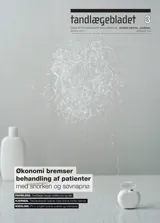Behandling af patienter med snorken og søvnapnø
Ca. 40 % af alle mænd og 30 % af alle kvinder snorker. Snorken kan være mere end blot en plage for både patienter og omgivelser. Det er tillige det primære symptom på obstruktiv søvnapnø (OSA). 30-50 % af alle snorkere lider i et eller andet omfang af OSA og oplever dagtræthed og obstruktive apnøer under søvn. Apnø-hypopnø-indeks (AHI) angiver antal apnøer/hypopnøer pr. times søvn; et AHI større end 5 betragtes som patologisk. Adskillige vejrtrækningsstop resulterer i dårlig søvnkvalitet og forårsager betydelig stresspåvirkning af de kardiovaskulære organer, hormonbalance samt nyrer. Denne konstante stressfaktor vil resultere i søvnighed og øget risiko for højt blodtryk, forhøjet kolesterol, kardiovaskulære sygdomme og tillige initiere insulinresistens, hvilket leder til diabetes type 2. De mest almindelige behandlingsmetoder er Continuous Positive Airway Pressure (CPAP), Mandibular Advancement Devices (MAD)-skinnebehandling og forskellige kirurgiske indgreb. Der er en betydelig geografisk variation i den behandling, der tilbydes den enkelte patient. I Sverige er MAD-skinnebehandling ofte førstevalg, hvor førstevalgsbehandling i Danmark oftest er CPAP. Der er brug for øget professionel opmærksomhed, således at behandlingsvalget træffes ud fra medicinske, sundhedsfaglige og ikke-økonomiske kriterier. MAD-skinnebehandling synes at være et sufficient førstevalg for en række patienter, og vi vil initiere forskning og søge dokumentation for denne behandlings effekt på patienternes generelle helbred.
Treatment of patients with snoring and sleep apnoea
An estimated 40 % of men and 30 % of women snore. Snoring can be more than just a nuisance. Snoring is also the primary symptom of obstructive sleep apnoea (OSA). 30-50 % of all snorers suffer to some extent from OSA and experience daytime sleepiness and obstructive apnoeas during sleep. The apnoeahypopnoea index (AHI) is the mean number of apnoeas per hour of sleep, and an AHI greater than 5 is considered pathological. Numerous stops in breathing result in a low quality of sleep and cause considerable stress to the cardiovascular organs and the balance of hormones and kidney function. This constant stress factor will result in sleepiness and increased risk of high blood pressure and cholesterol, cardiovascular diseases and additionally initiate resistance to insulin which can lead to type 2 diabetes. The most common treatments are continuous positive airway pressure, mandibular repositioning appliances, and various surgical modalities. There is a considerable geographic variation in choice of treatment offered to the patient. In Sweden, treatment using mandibular repositioning appliances is often first choice, whereas in Denmark treatment of first choice will be continuous positive airway pressure. We call for increased professional attention to whether the choice of treatment is based on an economic or medical considerations. The mandibular repositioning device seems to be apprippriate first choice of treatment for a number of patients and, thus, we will initiate research to document the implication of such devices to the patients’ general health.


